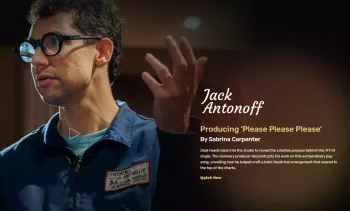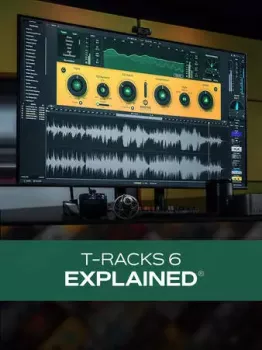Last updated 7/2019
MP4 | Video: h264, 1280x720 | Audio: AAC, 44.1 KHz
Language: English | Size: 1.47 GB | Duration: 1h 0m
英文简介:
An intermediate video survival guide and workshop that demystifies jazz bass by unlocking harmonic arpeggio music theory
What you'll learn
Improvise better bass lines on day 1
Discover how simple arpeggios can create dynamic jazz bass lines
Gain confidence playing bass and improvising (in any style)
Improve rhythm, groove and contour with targeted lessons
Requirements
You should be able to read bass tab
You should be familiar with common music theory concepts like triads, chords and scales
Ideally, you should be familiar with common intervals and scale degrees
Description
Jazz bass can be a fun to play. But, it can also seem overwhelming for many players. This video survival guide is short and sweet - focusing on music theory concepts like arpeggios, numerals, intervals and rhythm. Motivated jazz bassists will be encouraged to practice arpeggios against jam tracks, playing better improvisations on day 1. If you can already improvise a bass line over any set of changes, this course will be too basic for you. But, for everyone else, you'll be glad you invested your time to learn the material in this concise video workshop.5-Stars - "This is an excellent course that helped expand my understanding and use of arpeggios." -Walt (Udemy Student)Without the confidence to improvise a bold (and fun) bass line, jazz bass can become an ordeal. This course demonstrates an effective way to overcome common challenges by mastering arpeggios. You'll learn to use arpeggios and music theory to write (or improvise) bass parts that flow well and are fun to play. This workshop-style course is optimized to be short and sweet. Intermediate players may already know many of the concepts, but many non-experts will gain powerful new insights.Improvise better bass lines on day 1.Jazz bass is a lifelong pursuit for many players. It is impossible to imagine ever "knowing it all" when it comes to jazz. When I was a student (in both private and academic environments), nobody every suggested that I could transform my bass playing over the next 24 hours. But, looking back, I wish someone had helped me understand how and why the arpeggio could have helped me do EXACTLY that. Every time I've made a giant leap in my jazz bass playing, it was related to a deeper understanding of harmony (a.k.a. arpeggios). I've shared my insights with private students and bandmates for over a decade and now I'm explaining the whole process through these video lessons.Each brief video lecture either focuses on a specific music theory concept (arpeggios, inversions, intervals, etc.) or highlights how they can be used in the real world. I'm assuming that you are going to take these principles and run with them. We'll focus on the essential skills that will give you the confidence you need to play jazz and improvise bass parts on stage and in rehearsal. I'll make clear recommendations for what you should practice and I've prepared bass tab and jam tracks to make your journey more immediate and enjoyable.You'll learn to perform these valuable skills, essential to improvising good jazz bass lines:Using numerals to identify chord progressions Matching numerals to arpeggio qualities Major, minor, dominant, augmented, half-diminished and diminished arpeggios This course is a powerful primer for the right student - jazz bassists who already have a grasp of music theory fundamentals, but in need of practical strategy. Students should already understand the following music theory concepts:TriadsScalesMajor, Minor and Dominant ChordsProper Fretting TechniqueDemystify jazz bass improvisation with arpeggios... I did.As a bassist, you want to establish a reliable groove and keep listeners (and bandmates) engaged. In a word, you create the foundation, right? You'll get dynamic, adaptable tips for creating that foundation confidently in the real world... on stage. Plus, this approach unlocks any jazz standard or chord progression. Many jazz standards contain familiar harmonic patterns. There are patterns everywhere in music and mastering different arpeggios (major, dominant, diminished, etc.) on your bass is one of the most efficient and elegant ways to command your band and provide that foundation.Think of it! Confidence, certainty AND spontaneity. Learn from my experience as a gigging musician. Your bandmates will notice (and appreciate) when your bass parts support them more effectively. I've cultivated this curriculum in the world's greatest jazz laboratory - thousands of live gigs that I've played. Don't delay your musical potential - if you're struggling with improvising jazz bass lines, this course will give you a significant boost!This course represents the most useful lessons that I've learned. Plus, you'll benefit from my concise instruction - without wasting any time getting to the good stuff. You'll leverage your existing skills even further, while feeling more liberated (and creative)!Contents and OverviewFirst, you'll get a series of "refresher" lessons that will cover the essential music theory concepts we'll be talking about. Very basic, but fundamental - the introduction section reviews common, but important music theory concepts. Next, you'll begin learning every common arpeggio that (Western) music theory has to offer:MajorMinorDominantAugmentedHalf-Diminished (m7b5)Diminished (Fully)Section 2 concludes with practice recommendations integrated with a downloadable audio jam track. Plus, you'll get a quiz to help you evaluate whether or not you're ready to move on to the next section. These particular arpeggio lessons are crucial to developing a better way of thinking about chords and notes in terms of numbers and intervals. If you're struggling with "reading" changes in realtime, this approach (using arpeggio music theory) will thoroughly alter your perception of how a bass line can function under even the most complex jazz chord changes. You'll unlock your creative potential and begin feeling much, much more confident right away.Using the downloadable jam tracks - a 12 bar blues - gives you the perfect sandbox for practicing and improving your use of arpeggios. From Louis Armstrong to Charlie Parker (and even the flamboyant harmonic progressions of Coltrane and Wayne Shorter) the 12 bar blues has always been the preferred jazz "sandbox". The more you "play" the more you'll learn.Moving along, you'll discover (or rediscover) how inversions can open up a whole new world in your bass playing. Arpeggio inversions take practice, but you'll have a head start with easy-to-read bass tabs to get you started. You'll learn about "pedaling" and using inversions. This topic is extremely valuable for playing walking bass lines and I'll give you tips on how to "walk" confidently by using simple inverted arpeggios. These lessons also culminate in a hands on demo, practice recommendations and another quiz.Continuing your journey to improvisational confidence, we'll examine the topic of groove. I'll provide you with clear guidance for improving your timing. You'll also learn a simple system for practicing EVERY single possible (Western) rhythm by counting, navigating and omitting 1/8th and 1/16th notes. Playing jazz bass should be fun - not simply academic. Groove work is fun and powerful - don't miss it! The whole point of developing your chops is so that you can focus on the groove and have a good time, when you're on stage.Finally, you'll wrap things up by learning some easy-to-understand rules for creating great melodic contour. Once again, you'll find that arpeggios, arpeggio patterns and their harmonic relationship plays to your advantage (making contoured playing easier). Learn about employing (1) common tones, the (2) interval of a major 3rd and other intervalic patterns to ensure that your improvised bass lines flow and remain dynamic in realtime.Know where you're going. Know when you get there.Jazz bass is a big topic and this course is designed to boost your confidence when playing. Supplemental excercises include jam tracks, tabs and insights - all designed to support you as you develop your knowledge of arpeggios. If you're a beginner to jazz bass, this course may seem quite challenging (but approachable if you're motivated). If you're an expert, you'll likely feel these lessons are only review. But, if you're an intermediate student with a desire to learn and practice, this course on arpeggios and music theory will undoubtedly help you make significant gains. Free downloads include bass tab (proper arpeggio fingerings and example bass lines), audio files that complement each bass tab (so that students can use their ears to confirm that they're playing correctly) and midi files (that can be used by students in any practice software of their choice).Demystify jazz bass, starting today. These bass lessons can become your survival guide and you'll quickly find your footing with even the most challenging chord changes. As your instructor, I'm always engaged and available to answer questions. Enroll today and get started learning to improvise jazz bass with the music theory of arpeggios.
Overview
Section 1: Introduction
Lecture 1 Course Overview
Lecture 2 Demo: 12 Bar Bassline
Lecture 3 Instructor Introduction
Lecture 4 What is the Tonic?
Lecture 5 What is the Key?
Lecture 6 Review of Major Scale
Lecture 7 Chords by Numbers and Qualities
Lecture 8 Review of Dominant "V" Chord
Lecture 9 Intervals vs. Note Names
Section 2: Arpeggios to the Rescue
Lecture 10 Major 7 Arpeggio
Lecture 11 Minor 7 Arpeggio
Lecture 12 Dominant 7 Arpeggio
Lecture 13 Augmented (Both 7ths) and Half-Diminished
Lecture 14 Fully Diminished Arpeggio
Lecture 15 Hands On: Applying What You've Learned
Lecture 16 Hands On: Improvisational Practice
Section 3: Inversions & Walking Bass
Lecture 17 1st Inversion Arpeggios
Lecture 18 2nd Inversion Arpeggios
Lecture 19 Pedalling
Lecture 20 Hands On: Inversions Over 12 Bar Blues
Section 4: Groove Essentials
Lecture 21 Groove Overview
Lecture 22 Improving Your Timing & Tempo
Lecture 23 How to Practice Emphasis
Lecture 24 Subdividing By Eighths
Lecture 25 Subdividing By Sixteenths
Section 5: About Bass Line Contour
Lecture 26 Contour Overview
Lecture 27 Finding Common Tones
Lecture 28 Switching 3rds and 7ths
Lecture 29 Contour of Major 3rds
Lecture 30 What If You Have Questions?
Section 6: Conclusion
Lecture 31 Wrap Up
Lecture 32 Bonus Lecture: Additional Resources & Tools
Intermediate bass players who want a system and strategy for improvising bass lines,This course is NOT for you if you're already easily improvising jazz bass lines over any set of changes
官网: https://www.udemy.com/course/jazz-bass-arpeggio-survival-guide/






![French Connections: From Discotheque to Daft Punk – The Birth of French Touch by Martin James EPUB [EN]](https://audioz.download/uploads/posts/2024-09/thumbs/1727455731_407930774.webp)
评论0